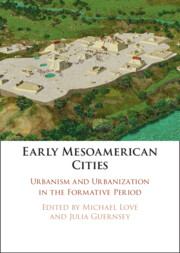Book contents
- Early Mesoamerican Cities
- Early Mesoamerican Cities
- Copyright page
- Contents
- Figures
- Tables
- Contributors
- Acknowledgments
- Chapter One Introduction
- Chapter Two Oaxaca’s Formative Period Cities and Their Implications for Early Urbanism in Mesoamerica
- Chapter Three Early Urbanization in the Formative Gulf Lowlands, Mexico
- Chapter Four Patterns of Early Urbanism in the Southern Maya Lowlands
- Chapter Five The Role of Middle Preclassic Placemaking in the Creation of Late Preclassic Yucatecan Cities
- Chapter Six The City over the City
- Chapter Seven The New Normal
- Chapter Eight The Nature of Early Urbanism at Teotihuacan
- Chapter Nine Art and Urbanity in Late Formative Mesoamerica
- Chapter Ten Landscape and Leadership in Mesoamerican Cities
- Chapter Eleven Experimental Cities?
- References
- Index
Chapter One - Introduction
Early Mesoamerican Cities, Urbanism, and Urbanization in the Formative Period
Published online by Cambridge University Press: 23 December 2021
- Early Mesoamerican Cities
- Early Mesoamerican Cities
- Copyright page
- Contents
- Figures
- Tables
- Contributors
- Acknowledgments
- Chapter One Introduction
- Chapter Two Oaxaca’s Formative Period Cities and Their Implications for Early Urbanism in Mesoamerica
- Chapter Three Early Urbanization in the Formative Gulf Lowlands, Mexico
- Chapter Four Patterns of Early Urbanism in the Southern Maya Lowlands
- Chapter Five The Role of Middle Preclassic Placemaking in the Creation of Late Preclassic Yucatecan Cities
- Chapter Six The City over the City
- Chapter Seven The New Normal
- Chapter Eight The Nature of Early Urbanism at Teotihuacan
- Chapter Nine Art and Urbanity in Late Formative Mesoamerica
- Chapter Ten Landscape and Leadership in Mesoamerican Cities
- Chapter Eleven Experimental Cities?
- References
- Index
Summary
Ancient Mesoamerica was a land of cities (Fig. 1.1). Above all, it was the number and the density of cities that distinguished Mesoamerica from the complex societies in neighboring areas of North America and lower Central America. Further, although ancient Mesoamerican cities interacted to varying degrees with those cultures to the north and south, they interacted most intensively with one another. It was the shared cultural practices produced by those relationships that define Mesoamerica (Kirchoff 1943; R. Joyce 2004a). In short, Mesoamerica is defined by its cities, their interactions with one another, and the cultural patterns created and sustained by those relationships. It is the beginnings of those cities, and their interactions, that form the principal themes of this volume.
- Type
- Chapter
- Information
- Early Mesoamerican CitiesUrbanism and Urbanization in the Formative Period, pp. 1 - 23Publisher: Cambridge University PressPrint publication year: 2022



